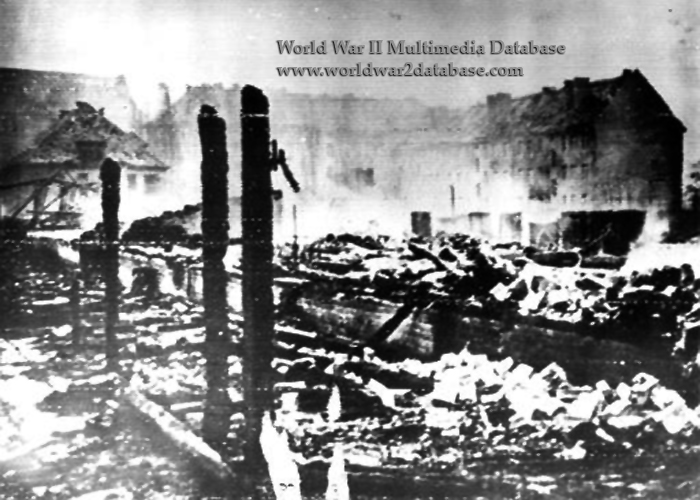| Remains of a Fremdarbeiter (Foreign Workers) barracks after the Royal Air Force raid of the night of December 16-17, 1943. 483 Avro Lancasters and ten DeHavilland Mosquitos destroyed parts of the city center, including the National Theatre, Archives, and much of the railways, delaying war materiel for the Eastern Front for a week. 25 Lancasters were shot down; a further 29 crashed attempting to land in United Kingdom in a fog. 300,000 foreign workers, classed into two groups, were in Berlin by December 1944. Gastarbeitnehmer (Guest Workers), were paid workers who volunteered to work in Germany, either Scandinavian or Axis Allies (Italy, Bulgaria, Romania, Hungary). about 1% of Germany‘s labor, initially had better housing, food, holidays, and vacation; these benefits were forcibly curtailed as Germany lost the war. 28% of the French Gastarbeitnehmer were reported to have failed to return to work after vacationing in France in 1943. Gastarbeitnehmer and Fremdarbeiter are now considered euphemistic terms for slave labor. Zwangsarbeiter (Forced Workers) were outright slave laborers, further divided into three groups: Militarinternierte (Military Internees) prisoners of war, initially mostly Poles; Zivilarbeiter (Civilian Workers) and Ostarbeiter (Eastern Workers) forcibly recruited in the Arbeitseinsatz (labour intake) by Ernst Friedrich Christoph “Fritz“ Sauckel (October 27, 1894 – October 16, 1946), General Plenipotentiary for the Employment of Labor from 1942 until the end of the war. Ostarbeiter were mostly ethnic Ukrainians forced into slavery, who endured the worst conditions and restrictions, including wearing “OST“ on their clothing and forbidding all contact with ethnic Germans. Conditions grew so bad that by 1944 there was little difference between the different worker groups. Denied access to Berlin‘s limited air raid shelters, the Fremdarbeiter suffered through the bombings as best they could. As food became scarce, more and more of the Fremdarbeiter attempted escape, leading the Gestapo to authorize the military and police to conduct executions as needed in late 1944. 7.7 million displaced persons were forced into labor in Germany by April 1945; on average, they worked and lived for less than two years before being left to starve in the death camps. 40,000 Poles and Soviets were dying each month in 1944, while Sauckel could only supply slightly less than that to replace them. Most were around age 16; half were women. Rape and sexual abuse were common. Sauckel was executed as a war criminal, decrying his innocence on the gallows. His superior, Albert Speer, received twenty years imprisonment. | |
| Image Filename | wwii0025.jpg |
| Image Size | 241.99 KB |
| Image Dimensions | 700 x 500 |
| Photographer | Unknown |
| Photographer Title | |
| Caption Author | Jason McDonald |
| Date Photographed | December 18, 1943 |
| Location | |
| City | Berlin |
| State or Province | Berlin |
| Country | Germany |
| Archive | |
| Record Number | |
| Status | Caption ©2007, ©2024 MFA Productions LLC Image in the Public Domain |

Author of the World War II Multimedia Database

